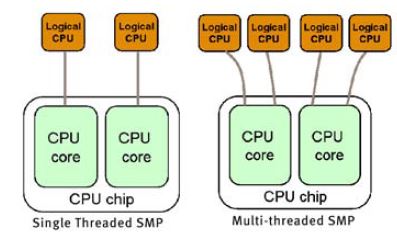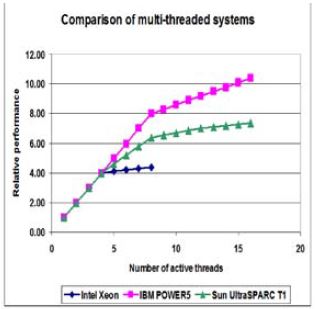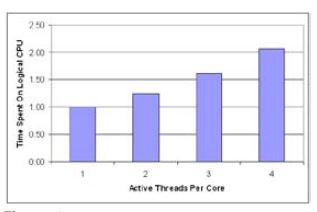Symmetric multi-processing (SMP) has been employed by computer makers for some time. Multiple processors are connected to a common memory pool and a combination of hardware and operating system functions permit work to be balanced across the entire unit. Each processor had a single “thread” that processed programming instructions.
Recently chip manufacturers added additional threads to the processors to further increase efficiency of the chips. The added capacity of multi-threaded processors is welcomed but they provide some challenges for the capacity planner. As work is added to a system, multi-threaded CPU cores perform differently from multiple single-threaded CPU cores in a symmetric multiprocessing (SMP) environment. The meaning of per-process CPU time measurements depend upon chip technology, therefore measurement results and expected future performance may not be intuitively obvious any more.
This paper explains a conceptual architecture developed for modeling multi-threaded processors and the new functionality provided in Vityl Capacity Management to support multithreaded processors. A modeling example using Linux on Intel chips will be provided to aid your understanding.
Single-threaded Versus Multi-threaded Symmetric Multiprocessing
Let’s begin by comparing older single-threaded SMP technology with newer multi-threaded technologies. In both cases, the CPU chip is the hardware component that provides the instruction processing capability. Within each chip there may be multiple CPU cores, and each core contains the complete functionality of what we used to consider a CPU.

Older SMP systems exhibited performance limitations as more CPU’s were added to a configuration. For those of us familiar with the history of mainframe computers, we saw that each incremental processor added a lesser amount of additional capacity. In fact, one vendor, Amdahl Corporation, increased the computational power of the last two processors in their 12-way computer in order to overcome the SMP shortfall. These limitations resulted from hardware and operating system architectures designed to ensure data integrity through the use of various tactics such as signaling and locks. Over the years, all the major vendors have made significant improvements in this area. As a result, most SMP systems today have near linear performance scaling in the hardware and operating systems.
In a multiprocessing architecture, there are two approaches to providing additional processing power. Each additional core, bearing a single logical CPU, delivers a nearly equal quantity of CPU capacity. In most of today’s architectures, this results in a commensurate increase in capacity when cores are added. The multithreading option adds multiple threads to each core. Each thread adds some additional amount of CPU capacity. However, because these threads share the CPU core resources, the addition of a thread typically delivers only a portion of the capacity of a single-threaded core.
Examples of multi-threaded chips include Sun UltraSPARC T1 and T2, SPARC64 VII, Intel Xeon, Intel Itanium2, Intel Pentium 4, IBM POWER5 and IBM POWER6.
Performance Scaling in Multi-threaded Systems
When more threads are added to cores in multi-threaded systems, performance depends upon chip technologies. All deviate from a linear growth line graph once you get beyond the point where a single thread is active on each core and core resources are shared.
Chip performance differences as seen during TeamQuest testing can be seen in Figure 2.

Intel Xeon (2 chips, 2 cores per chip, 2 threads per core) delivers minimal performance gain once four threads are exceeded.
Sun UltraSPARC T1 (1 chip, 4 cores per chip, 4 threads per core) shows a linear increase in performance up to four threads, slightly degraded performance when there are two threads per core active, and then only nominal gain after core sharing increases as more than two threads become active.
IBM POWER5 (4 chips, 2 cores per chip, 2 threads per core), shows linear gain up to eight threads (one per core) and then the gain per thread drops from that point forward.
Where performance becomes non-linear, it is because more than one thread has become active on a CPU core. Similarly, when you view transaction behavior with multi-threaded CPUs you see some interesting results.

The results show that the best performance for a single transaction comes when there is only one CPU hardware thread is active on the core on which it is consuming resources.
However, even though each logical CPU runs slower when multiple threads (logical CPUs) are active, there is a greater total capacity. It is the same whether two active threads on a core or more. The best throughput (transactions completed per second) occurs when all CPU hardware threads are active.
Revised Modeling Approach
When modeling multi-threaded environments the statistics are collected when multiple threads in the core are active, but the model tool requires as input the CPU service requirement when a single thread is active in the CPU. This will require some computation on the collected statistics.
The ideal statistics needed for precise modeling of multi-threaded environments are:
- Number of active threads per core
- Time spent on CPU
- Change in workload performance
Then we could use the formula here to compute a service time that reflects how a transaction would behave if a single thread was active.

Unfortunately, vendors don’t provide this level of detail in multithreaded chips. To overcome the problem, we use available CPU statistics such as CPU seconds and logical CPU % busy. Then we solve a small model, with no user intervention, when the model is loaded to compute the single thread CPU service requirements.
Vityl Capacity Management has included the concept of a load-dependent server for some time, but it is now being put to a new use; it has been employed to model the CPU Active Resource Queue. An LDS server is where the rate of service varies depending on the queue length.
When modeling CPU Active Resource Queue in a multi-threaded environment, LDS is activated and CPU Active Resource Type is displayed as “THREAD.”
The LDS requires the use of speedup factors. Since there are diminishing returns when adding threads to a core, speedup factors are necessary to maintain accuracy when adding threads to cores within the LDS. Vityl Capacity Management contains default speedup factors for many popular CPUs. The default speedup factors that we provide come from a combination of industry literature and our own testing experience. If you have performed application scalability testing in such environments and your application scales differently, Model provides a way for you to change the default values to better reflect your environment.
The Vityl Capacity Management GUI now has several changes which make it easy to model today’s multi-threading architectures. Instead of only being able to define CPU hardware using a CPU equipment name and the Number of CPUs, The hardware dialog box now expands the options to include a CPU equipment name, number of chips, number of cores per chip, and the number of threads per core. Most of the time Vityl Capacity Management knows the details for commonly used chips.
Speedup factors are also easy to adjust using the new GUI. A dialog box appears with the default speedup factor for the System Type selected and the number of threads per core that was specified. This is where you can adjust the default speedup factors with data derived from your own application tests or other credible sources.
On Windows, Linux, HP-UX, and VMware platforms with Intel hyperthreaded CPU hardware, you can control whether multi-threading is on or off at the CPU or hardware level. The Physical CPU Settings dialog box (accessed via the Active Resources spreadsheet by pressing the button in the Number of Servers column) allows you to control hyper-threading on or off just as you can with the real hardware. The hardware is capable of two threads per core, but if you set hyper-threading to “Off” the resulting number of servers per core will be reported as one.
The IBM AIX platform also has controls to turn Simultaneous Multithreading on or off, but it is controlled at the Logical CPU level, not the Physical CPU or hardware level. Press the button in the logical CPU Number of Servers column and you will see the Logical CPU Settings dialog box. Here you can control the number of virtual CPUs that are assigned to this logical system and whether multi-threading is on or off at the logical system.
Sun Solaris platforms do not have any controls to turn multithreading on or off. It is always on.
Summary
As you can see, there are substantial differences between single-threaded and multi-threaded architectures. In order to deal with the changes, TeamQuest (now part of Fortra) has incorporated a number of changes to facilitate your capacity planning activities when employing modeling techniques for multi-threaded architectures. The new capabilities combined with the easy-to-use Vityl Capacity Management interface makes it easy to predict application and service performance on the new multi-threaded architectures.
You need to be cognizant of the differences between the single and multi-threaded technologies and understand their impacts on your applications and services. Armed with that information and Vityl Capacity Management’s new capabilities, you will be able to easily predict future performance, no matter what technology you choose.
Try Vityl Capacity Management for Yourself
See how Vityl Capacity Management makes creating capacity plans for any IT environment simple and easy without sacrificing the powerful technology you need. Take a self-guided tour to try the software today!